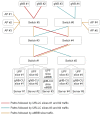5G Infrastructure Network Slicing: E2E Mean Delay Model and Effectiveness Assessment to Reduce Downtimes in Industry 4.0
- PMID: 35009771
- PMCID: PMC8749764
- DOI: 10.3390/s22010229
5G Infrastructure Network Slicing: E2E Mean Delay Model and Effectiveness Assessment to Reduce Downtimes in Industry 4.0
Abstract
Fifth Generation (5G) is expected to meet stringent performance network requisites of the Industry 4.0. Moreover, its built-in network slicing capabilities allow for the support of the traffic heterogeneity in Industry 4.0 over the same physical network infrastructure. However, 5G network slicing capabilities might not be enough in terms of degree of isolation for many private 5G networks use cases, such as multi-tenancy in Industry 4.0. In this vein, infrastructure network slicing, which refers to the use of dedicated and well isolated resources for each network slice at every network domain, fits the necessities of those use cases. In this article, we evaluate the effectiveness of infrastructure slicing to provide isolation among production lines (PLs) in an industrial private 5G network. To that end, we develop a queuing theory-based model to estimate the end-to-end (E2E) mean packet delay of the infrastructure slices. Then, we use this model to compare the E2E mean delay for two configurations, i.e., dedicated infrastructure slices with segregated resources for each PL against the use of a single shared infrastructure slice to serve the performance-sensitive traffic from PLs. Also we evaluate the use of Time-Sensitive Networking (TSN) against bare Ethernet to provide layer 2 connectivity among the 5G system components. We use a complete and realistic setup based on experimental and simulation data of the scenario considered. Our results support the effectiveness of infrastructure slicing to provide isolation in performance among the different slices. Then, using dedicated slices with segregated resources for each PL might reduce the number of the production downtimes and associated costs as the malfunctioning of a PL will not affect the network performance perceived by the performance-sensitive traffic from other PLs. Last, our results show that, besides the improvement in performance, TSN technology truly provides full isolation in the transport network compared to standard Ethernet thanks to traffic prioritization, traffic regulation, and bandwidth reservation capabilities.
Keywords: 5G; delay; infrastructure slicing; isolation; network slicing; private networks; response time.
Conflict of interest statement
The authors declare no conflict of interest.
Figures










Similar articles
-
On the Rollout of Network Slicing in Carrier Networks: A Technology Radar.Sensors (Basel). 2021 Dec 3;21(23):8094. doi: 10.3390/s21238094. Sensors (Basel). 2021. PMID: 34884098 Free PMC article.
-
A Comprehensive Overview of Network Slicing for Improving the Energy Efficiency of Fifth-Generation Networks.Sensors (Basel). 2024 May 20;24(10):3242. doi: 10.3390/s24103242. Sensors (Basel). 2024. PMID: 38794095 Free PMC article. Review.
-
An E2E Network Slicing Framework for Slice Creation and Deployment Using Machine Learning.Sensors (Basel). 2023 Dec 4;23(23):9608. doi: 10.3390/s23239608. Sensors (Basel). 2023. PMID: 38067981 Free PMC article.
-
Slice Management for Quality of Service Differentiation in Wireless Network Slicing.Sensors (Basel). 2019 Jun 19;19(12):2745. doi: 10.3390/s19122745. Sensors (Basel). 2019. PMID: 31248088 Free PMC article.
-
Design, Development, and Evaluation of 5G-Enabled Vehicular Services: The 5G-HEART Perspective.Sensors (Basel). 2022 Jan 6;22(2):426. doi: 10.3390/s22020426. Sensors (Basel). 2022. PMID: 35062386 Free PMC article. Review.
Cited by
-
Data Freshness and End-to-End Delay in Cross-Layer Two-Tier Linear IoT Networks.Sensors (Basel). 2022 Dec 3;22(23):9455. doi: 10.3390/s22239455. Sensors (Basel). 2022. PMID: 36502157 Free PMC article.
References
-
- Prados-Garzon J., Ameigeiras P., Ordonez-Lucena J., Muñoz P., Adamuz-Hinojosa O., Camps-Mur D. 5G Non-Public Networks: Standardization, Architectures and Challenges. IEEE Access. 2021;9:153893–153908. doi: 10.1109/ACCESS.2021.3127482. - DOI
-
- 5G for Business: A 2030 Market Compass. Setting a Direction for 5G-Powered B2B Opportunities. Ericsson; Stockholm, Sweden: 2019. White Paper.
-
- Casado M., McKeown N., Shenker S. From Ethane to SDN and Beyond. SIGCOMM Comput. Commun. Rev. 2019;49:92–95. doi: 10.1145/3371934.3371963. - DOI
-
- Feamster N., Rexford J., Zegura E. The Road to SDN: An Intellectual History of Programmable Networks. SIGCOMM Comput. Commun. Rev. 2014;44:87–98. doi: 10.1145/2602204.2602219. - DOI
-
- Mijumbi R., Serrat J., Gorricho J.L., Bouten N., De Turck F., Boutaba R. Network Function Virtualization: State-of-the-Art and Research Challenges. IEEE Commun. Surv. Tutor. 2016;18:236–262. doi: 10.1109/COMST.2015.2477041. - DOI
MeSH terms
Grants and funding
LinkOut - more resources
Full Text Sources

